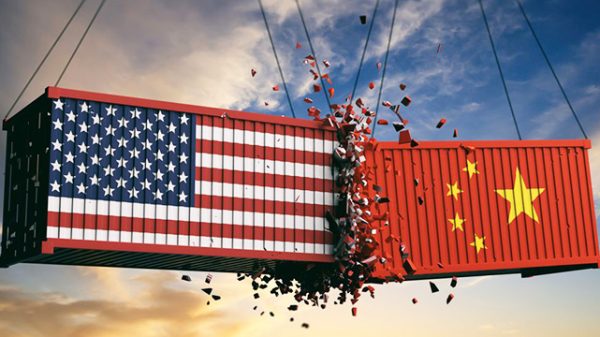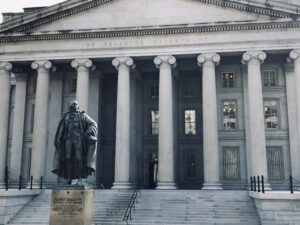In an April 27 post on Truth Social, President Trump floated a politically ambitious idea: replacing federal income taxes — at least for Americans earning under $200,000 per year — with revenue raised from tariffs.
No more IRS filings for the middle class, no more paycheck deductions. Instead, foreign producers would foot the bill through duties imposed on goods sold into the United States. It is a vision designed to appeal to taxpayers weary of complex, costly filings and mounting fiscal burdens. But appealing ideas are not always economically feasible. Even with generous assumptions, basic analysis shows that the plan is impractical and would be deeply damaging. A straightforward, back-of-envelope exercise reveals why.
First, consider the gap that would need to be filled. In fiscal year 2023, the federal government collected approximately $2.2 trillion in individual income taxes, according to the Congressional Budget Office (CBO). Meanwhile, total imports of goods and services into the United States totaled about $3.9 trillion, per the Bureau of Economic Analysis (BEA). If the goal is to eliminate the $2.2 trillion raised by income taxes and replace it entirely with tariffs, the simple calculation is:
Tariff Rate Needed = $2.2T / $3.9T = approx 56 percent
At first glance, it seems that a 56 percent across-the-board tariff on all imports could theoretically generate the necessary revenue. But this first approximation ignores how individuals, businesses, and trading partners would actually respond to such a shock.
The real economy is dynamic, not static. If tariffs were raised to 56 percent, several predictable consequences would quickly unfold. Imports would decline sharply, as US consumers and firms, facing vastly higher prices, would reduce purchases of foreign goods. While Penn Wharton projects large trade declines from tariffs, import price elasticities — typically between -1.5 and -2.0 — suggest that tariffs of 50 percent to 100 percent would shrink import volumes by 60 percent to 80 percent. For illustration, if imports shrank by 40 percent, the new import base would fall to about $2.34 trillion.
To still raise $2.2 trillion in revenue from a much smaller volume of imports would require recalculating:
Tariff rate needed = $2.2T / $2.34T = approx 95 percent
In short, a 95 percent tariff — nearly doubling the cost of every imported good — would be necessary to generate the same revenue after accounting for reduced imports. And this estimate still assumes that tariff evasion, product mislabeling, and black-market smuggling would not further erode the tax base — an unrealistic assumption.
To be fair, Trump’s April 27 post appeared to suggest a somewhat narrower proposal: replacing income taxes only for individuals earning under $200,000 per year. That adjustment reduces the revenue gap. IRS data shows that individuals earning $200,000 or less account for about 54 percent of total federal income tax collections. Thus, approximately $1.19 trillion would need to be replaced. Using only goods imports (roughly $3.08 trillion in 2023, excluding services), the tariff required would be about 39 percent — if no behavioral change occurred. But if imports shrank by 50 percent under steep tariffs, the necessary tariff rate would rise to approximately 77 percent. Even this more modest goal would trigger severe economic disruptions: major inflation, deep recession, and widespread supply chain disorder.
Beyond the technical difficulty of collecting such revenues, the broader economic consequences would be devastating. Raising tariffs to 77 percent or 95 percent would effectively sever the United States from global supply chains, driving up the costs of not just imported goods, but also domestically manufactured products that rely on foreign components. Prices for automobiles, electronics, apparel, and machinery would soar. In many sectors, shortages would emerge as supply chains collapsed or failed to reorganize quickly enough.
History offers a sobering warning. During the early 1930s, the Smoot-Hawley Tariff Act raised average tariffs to about 20 percent, leading to a two-thirds collapse in world trade, a 50 percent drop in US exports, and a 30 percent contraction in US GDP. Compared to Smoot-Hawley, a 77 percent or 95 percent tariff regime would be catastrophic. Conservative estimates suggest GDP could fall between 8 percent and 15 percent, representing a $2.2 trillion to $4.0 trillion loss in economic output — equivalent to or worse than the Great Depression.
Inflation, meanwhile, would explode. Imports account for about 15 percent of direct US consumption, and when embedded in finished goods, contribute to roughly 25 percent to 30 percent of total consumer spending. Doubling or tripling the cost of imported goods would ignite a chain reaction. Analysts would reasonably expect consumer price index (CPI) inflation of between 20 percent and 40 percent in the first year alone — higher than anything seen since the 1970s, when inflation peaked at around 14 percent.
Wages, which tend to adjust slowly, would not keep pace. Households would experience a swift and painful decline in real purchasing power. For the very middle-class families the plan is meant to help, real incomes would fall sharply, and living standards would deteriorate.
It is important to note that these figures are necessarily estimates, and different assumptions about elasticity, retaliation, and substitution could shift these numbers. Yet even under favorable assumptions, the sheer scale of tariffs required to replace even part of the income tax — and the economic distortions those tariffs would unleash — make the idea untenable. The dream of painless taxation funded by foreign producers collapses under the weight of basic economic logic and analysis.
As appealing as it sounds to shift the tax burden away from American paychecks and onto foreign goods, the real-world consequences would be catastrophic: mass inflation, deep recession, supply chain breakdowns, falling real incomes, and a likely spiral into protectionist-created economic decline.









